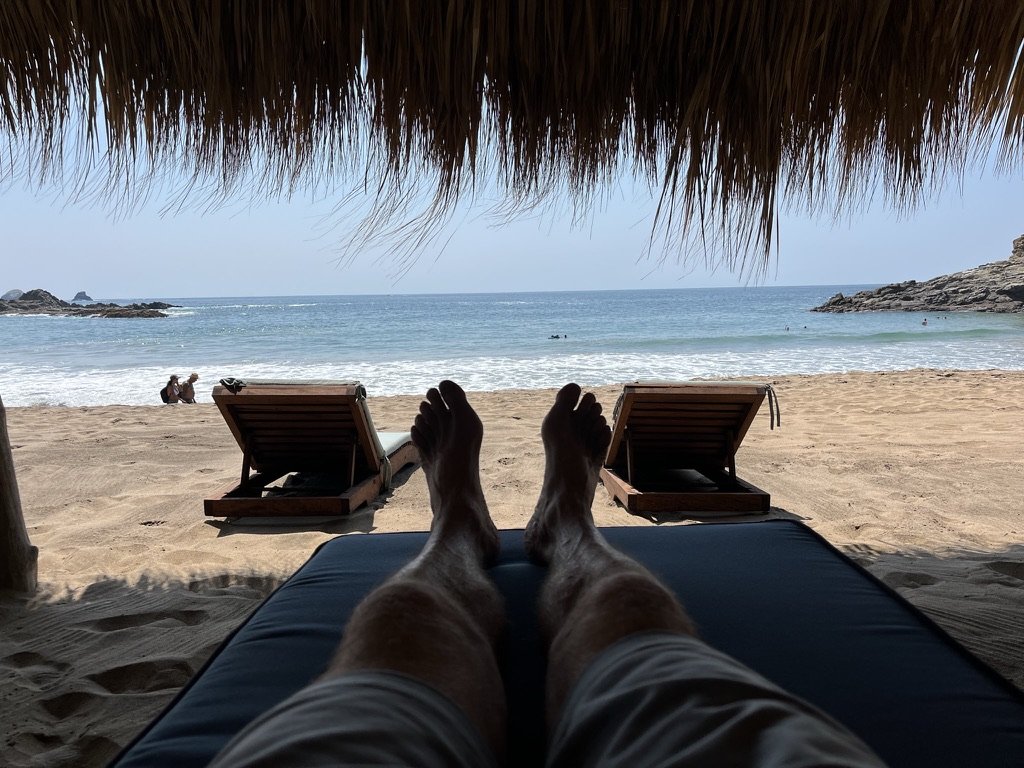Topes and Travel
Oaxaca Reset
Rob Forbes | 4-28-2023
Mexico was calling. I needed a reset from my daily life and routines at home. A favorite younger friend had died recently out of the blue and a peer had been diagnosed with early onset Alzheimers. I had just ripped a rotator cuff and been whacked with some painful knee issues – all doses of reality/mortality that, I can’t help but notice, are becoming increasingly common. Beth and John, two close pals, needed a break from the Maine winter. A week of culinary and beach indulgence with friends on the Oaxacan coast followed by a thousand mile drive back to California from the southern tip of Baja seemed like a good idea.
Our assignment was to retrieve my ‘95 Toyota 4Runner that I had left there four years ago when the pandemic hit. Should we choose to accept this mission in light of weekly headlines about cartel killings down there? I’d been to Mexico maybe fifty times since childhood and never had any scary encounters – it was go time.
We exit the Hualtaco airport in our rental car (a stranded Canadian musical director in need of a lift scrunched with the luggage in the back seat). We check for directions on phone GPS and road signs simultaneously, and, bammo, hit an unmarked speed bump which thunks the chassis, splashes assorted dashboard drinks onto assorted laps, and says ‘Welcome to Mexico. Slow down’.
In Mexico speed bumps are called topes (toe pays). They remind us to be present, to consider our surroundings and to be considerate of others. They can be seen as yoga–like mantras for mindfulness. Or they could just be speed bumps.
No two topes were identical in the small coastal towns in Oaxaca we visited. They varied in size, shape and signage (if any) depending on the town – as if designed and installed by some artisanal local shop. They call attention to the specificity of place and help us appreciate local culture and communities. The way they pop up randomly makes them useful symbols of the unpredictability of our lives. Or they could be just speed bumps.
Topes are economic alternatives to our complex and costly systems of speed control, replacing Highway Patrol officers, radar, flashing digital signage. As such they are excellent examples of modern design. Are they effective deterrents to reckless driving? Hard to say. Annual car deaths per capita in Mexico are about the same as in the US (13 deaths per 100,00). They are not a total solution by any means. But they remind us that simplicity can best technology in many cases. Or they could be just speed bumps.
I knew Oaxaca from previous visits to its capital city – a magical place, but the small coastal towns on the Pacific – Zipolite, Mazunte, San Agustinillo – were all new to me. Unlike Cancun, they are happily not yet developed for, and overrun by, tourists. The curvy, bumpy roads and stealthy topes don’t make for easy, mindless travel. The communities are eclectic, mostly Mexicans, Canadians, and Europeans, fewer Americans. It’s a welcoming place for hippies, gays, nudists, surfers, beach bums, vegans, yogis, and man buns. The vibe, like the palapa architecture, is relaxed and casual and many homes and cafes are open to the elements year round. The locals are super friendly even though they are still reeling (and many are still homeless) from the devastating hurricane Agatha in 2022, They were delighted to have tourists around dropping some cash.
Balmy breezes, warm water, mangoes, coconuts, fresh ceviche from dorados (Mahi-Mahi) caught right offshore, the sound of pounding ocean waves all night made it an easy place to reset your mind and body. What made this place especially peaceful was the fact the locals and the tourists genuinely seemed to enjoy and respect each other, anxieties softened by the natural beauty and warmth.
Mexicans were taking selfies on the beach as often as foreign tourists. The usual symbols of wealth – fancy cars, fashion, designer handbags – were nowhere to be seen. I cannot remember any discussion about politics. There was this optimistic sense that diverse groups can exist together compatibly without an overarching set of hierarchies, rules or social mores.
Boys, girls, mothers with kids, guys in pairs, are all riding mopeds without helmets in shorts and sarongs, often in flip flops, all year round. Many people were going barefoot everywhere, and this might be the defining cultural detail to this place. Topes made all this barefootin’ possible, keeping cars moving at a snail’s pace – the streets and sidewalks were chill and safe.
For highbrow art and culture, Puerto Escondido is just down the road, with the amazing Tadao Ando inspired Foundation Casa Wabi, astounding designer hotels on a deserted stretch of beach. Spas, steam rooms, omakase, parking valets, chic guests. But barefooting, topes, cheap eats, and societal permissiveness are absent. You know you are back in the modern world. These high-tech sporty designer booties seen in the hotel café seemed symbolic of the cultural shift. Footwear, or its lack, may be as good a guide to cultural priorities as anything. Or they might just be footwear.
The Oaxacan week kicked off my reset, but the Baja road trip took it to another level. Coming soon.













